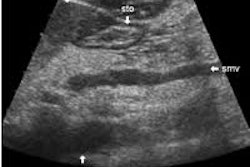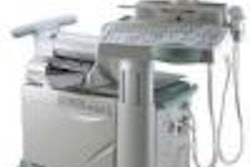Utilization of musculoskeletal ultrasound is increasing, but so is the number of procedures being performed by non-radiologists, according to research presented at the 2002 RSNA meeting in Chicago.
"Radiologists need to be aware of the impending turf battle for musculoskeletal ultrasound," said Dr. Levon Nazarian from Thomas Jefferson University (TJU) in Philadelphia. "Radiologists must learn this exciting modality or risk losing it."
The TJU study team examined the nationwide Medicare Part B databases from 1996 to 2000. Physician providers were classified using Medicare specialty codes, and the group also calculated utilization rates per 100,000 beneficiaries per year for the CPT 4 code used for musculoskeletal ultrasound (76880).
Overall, musculoskeletal ultrasound utilization per 100,000 Medicare beneficiaries climbed 29.9%, from 150 to 195. In 2000, radiologists held on to the lion's share of the procedures, performing 67.9% of the exams.
Podiatrists contributed 6.8%, while multispecialty groups generated 6.7%. Internists produced 2.7% of cases, while general practitioners handled 2.4% of the procedures. The remaining 45 specialties performed the remaining 13.3% of the studies, Nazarian said.
Radiologist utilization climbed from 115.4 per 100,000 beneficiaries in 1996 to 133.1 in 2000, up 15.3%. However, that percentage growth was surpassed by every other specialty, Nazarian said.
"There is not a single specialty that we studied that had a lower percentage increase than in radiology," he said.
Podiatrists showed the biggest gains in percentage terms, climbing 1,025%, from 1.2 to 13.2. Utilization by multispecialty groups was 13.2 per 100,000 exams in 2000, a gain of 21.7% from the 10.8 notched in 1996. Internists contributed 5.2, up 77.8% from 2.9 in 1996.
General practitioners performed 4.8 per 100,000 procedures in 2000, up 250.2% from the 1.4 posted in 1996. Utilization by all other specialties reached 26 per 100,000 cases in 2000, up 38.6% from 18.7 in 1996.
Nazarian said the limitations of the TJU study included its focus on the Medicare patient population, and the inability to break out studies by exact body part using the database. In addition, data attributed to multispecialty groups may have also included studies contributed by radiologists, he said.
Cost savings?
In a related presentation at the RSNA meeting, the TJU team determined that replacing musculoskeletal MRI with musculoskeletal ultrasound in appropriate cases could yield annual cost savings in the Medicare population of between $40.3 million to $153.4 million.
In this study, which also included examination of Medicare musculoskeletal imaging trends between 1996 and 2000, as well as utilization and cost projections for 2005 and 2010, the researchers reviewed the HCFA Physician/Supplier master summary files for 1996 to 2000. Musculoskeletal procedure volume for angiography, CT, MRI, ultrasound, and x-ray studies were determined, and rates per 100,000 were calculated using Medicare fee-for service beneficiaries as a denominator.
The researchers performed linear regression on the five years of data to create prediction equations for utilization rates, and a cost factor for each modality was estimated by dividing Medicare payments for the modality by the procedure volume in 2000. This information was used to produce per capita cost estimates and was multiplied by U.S. Census Bureau projections to produce total cost estimates, according to the researchers.
As a whole, 48,855 musculoskeletal imaging studies per 100,000 patients were conducted in 2000, up 4.2% compared with the 46,900 posted in 1996. By modality, CT grew 75.3% from 140 to 245, with MRI surging 113.6% from 756 to 1615. Ultrasound grew 33.5% from 150 to 201, while x-ray continued to make up the lion’s share of musculoskeletal imaging studies, with volume inching up 2.1% from 45,854 to 46,794.
The researchers projected that utilization of musculoskeletal imaging would increase 1.4% to 49,553 in 2005, and 3.7% to 50,669 in 2010. Costs, however, would rise 38% to $18.41 per capita in 2010. MRI would be the big culprit, contributing 49.5% of the total in 2010. In 2010, musculoskeletal imaging in the Medicare population over 65 would reach $731 million, the researchers determined.
The group then estimated the number of MRI exams that could be replaced by ultrasound studies from the TJU hospital information system, and projected cost savings by replacing varying percentages of MRI scans with ultrasound. Assuming linear changes in utilization and no changes in reimbursement rates, they calculated potential savings from using ultrasound ranging from $40.3 million to $153.4 million.
By Erik L. RidleyAuntMinnie.com staff writer
January 31, 2003
Related Reading
Spatial compound sonography improves musculoskeletal tissue definition, December 17, 2002
Imaging by non-radiologists drives up healthcare costs, November 25, 2002
Turf Wars in Radiology, Part V: Radiologists, orthopedists put best foot forward, October 1, 2002
The role of MRI and US in acute hamstring injuries: A preliminary report, July 22, 2002
Copyright © 2003 AuntMinnie.com




















